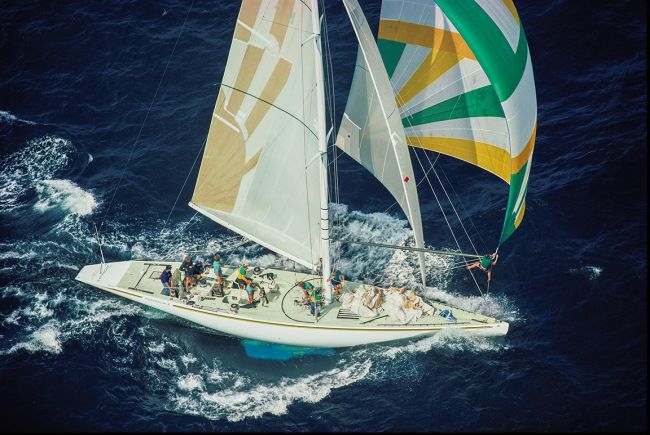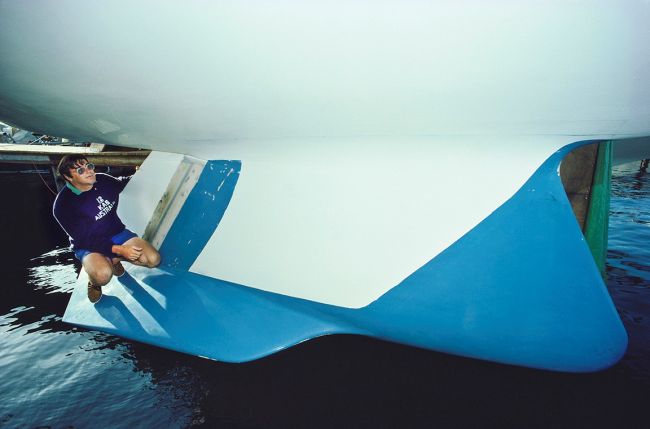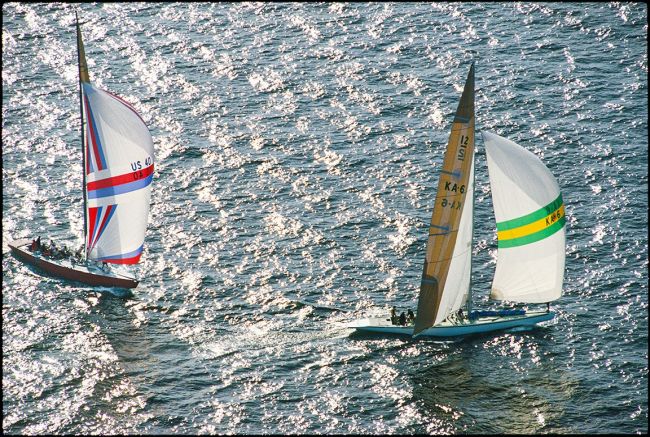When we see recent America's Cup boats that can foil along above the water at nearly 100 kph, we can only marvel at the way in which a machine blown along by the wind can travel many times faster than the wind itself! The level of technology currently in the sport can be seen by who is taking part: the current "Challenger of Record" for the cup regatta in Barcelona in 2024, INEOS Britannia, has its HQ based at the Mercedes AMG-Petronas F1 Team at Brackley, which is 8 miles from Britain's Formula 1 circuit but over 100 miles from the Solent where British AC regattas tend to be held. The team's CTO, James Allison, has at least four F1 Constructors' Championship titles under his belt as team Technical Director. One would imagine therefore that it is now that the most revolutionary boating inventions are being made. We'd counter that by suggesting we look right back to 1983.

Australia II at top speed on a three-sail reach on her way to breaking the longest successful cup defence – 132 years - of any sport. Her special invention, the keel, can be seen under water. (© Dan Nerney 1983)
Back in 1983, the famous New York Yacht Club had held the cup for 132 years, with 24 successful cup defences in the longest winning streak ever known in any sport.
In preparation for the 1983 season, prospective challengers arrived from Britain, Australia, Canada, France and Italy to fight it out in the challengers' regatta for the right to challenge the New York Yacht Club one-against-one. It soon became obvious, from the shuttering placed under her, that one of the Australian yachts, Australia II, may have something special going on with her "bodywork" under the waterline. Questions were raised as to whether she met the rules as a "12 Metre", a boat normally just over 20 metres long: but she had passed her measurements tests in Australia.
Known colloquially as "lead-bottomed money gobblers", 12 Metre boats not only were very expensive to operate competitively but had a keel weighing in at 20 tonnes or so of their 30-something tonnes of total weight. The essential purposes of the keel, normally a vertical fin extending down under the boat, are to provide a righting moment against the forces of the sails and to stop the boat being blown sideways by the wind, the angle at which a boat is blown sideways being known as "leeway".
Australia II's keel, at least on the patent applications filed for it, was attributed to a Mr Ben Lexcen. Ben already had a pedigree both as a sailor and designer: he had competed in the 1972 Olympics, he designed and won the 18-Footer Championships in his own boat, and was the designer of the International Contender, at the time the fastest class of single-hander at many sailing clubs. Now he was named as the inventor of Australia II's keel.
Ben's patent applications for the keel appear to allude only to part of what the one used on Australia II did!

Fig. 1 of Ben's patent application GB 2 114 515 A
Figure 1 in the application shows a generally horizontal fin (or wing) 5 on the vertical keel 2 and claim 1 was to "A sailing yacht having a keel below its hull in which the keel, in the vicinity of the tip, and on each side of the keel, is provided with at least one fin." The patent application explained how the (sideways) lift of a normal keel without wings generates vortices associated with induced drag (modern aircraft have winglets on their horizontal wings to reduce induced drag) and suggested that the wings 5 reduce drag or increase (sideways) lift; that the wings increase the depth of the keel as the yacht heels, and that using the wings it is possible to lower the centre of gravity of the ballast weight thereby increasing the righting moment.

Fig. 2 of GB 2 114 515 A
Other than the fact that the patent office search reports on the applications found at least one earlier design of vessel with a generally horizontal underwater wing of sorts, there were three striking things that were apparently missing from the patent application compared to the keel that was actually produced for Australia II:
First, though it's really obvious to say it with hindsight, Ben's keel was upside down!!!
This is clearly shown in Figure 1 of the patent application but it is not stated anywhere in the description. Turning the keel upside down had moved the ballast weight even further down. The same righting moment could therefore be achieved with a lighter keel. The overall configuration would also enable the yacht to turn faster – an important issue as a yacht has no drive as it turns through pointing its head to wind - and quite possibly to accelerate faster too.
Also not shown in the patent application is the fact that, whereas a "normal" keel often thins out from top to bottom, Australia II's keel became thicker from top to bottom, again a feature for lowering the centre of gravity and increasing the righting moment or for reducing weight.
Finally, though this was common at the time on 12 Metre yachts, Australia II had a "trim tab" on the rear edge of the vertical keel. A trim tab is like a plain flap on an aircraft wing and in the context of a yacht serves at least four purposes: (1) with a normal keel, sailing upwind, there is usually a need to use the yacht's rudder to apply what is known as "weather helm" to apply a torque to counter the yacht's tendency to want to turn into the wind (though the opposite maybe be true), so the trim tab can be rotated so as to reduce this tendency and thus the induced drag of the rudder; (2) the trim tab can be used to increase the sideways lift of the keel so as to reduce the leeway and associated hull drag caused by the hull moving slightly sideways through the water instead of straight ahead; (3) as an important benefit of that, it is possible to leave a wake over the water that points higher into the wind than would otherwise be the case, enabling the yacht to "sail right over" (overtake on the windward side) a competitor that has no trim tab; and (4) a trim tab can alter the angle of attack of the keel to improve its operational positions on its lift and drag curves.

Ben Lexcen with the invention that ended the longest winning streak in the history of any sport: the keel of Australia II. Ben's left hip is next the (white) trim tab on the trailing edge of the keel, Ben is crouching on one of the famous wings of the keel and, mind-blowing at the time, the keel, which weighs probably just over 20 tonnes including the wings, is located upside down on the hull. (Photo: © Dan Nerney 1983)
It's an understatement to say that those gathered for the 1983 America's Cup sailing were very keen to know what Australia II's keel was like, in case they should try to replicate its features or indeed if they could knock it out as "illegal".
Some details of the keel became known or at least were thought to be known, though in at least one case the details may have come from someone in the Australia II team "accidentally" leaving drawings of a completely different keel in a photocopier.
Others planned to make underwater observations of the keel, the result of the most industrious of these efforts supposedly involving a diver acting for one of the teams being caught snooping near the boat and later the same day appearing before a judge in Rhode Island as a defendant famously dressed in a wet suit!
Due to strategic timing of Ben's patent applications, they didn't publish so as to show that Australia II may use large wings on an "upside down" keel until it was too late for other teams to react. This was a brilliant piece of patent strategy as publication even a few months earlier could have been disastrous, perhaps even giving other teams enough time to build entirely new hulls with upside down keels and wings.
The allegations concerning the "illegality" of Australia II's keel extended at one point as far as alleging that the keel had been designed in the Netherlands rather than Australia as required by the rules.
We make no comment on that matter, contentious in the past, though we note – and it is nothing more than a formal choice – that Ben's first patent application was filed in the Netherlands.
Others (the British and Americans in particular) tried out "winglets" on their own keels but eventually did not adopt them. They already had very heavy keels that were the "right way up" and the winglets they tried probably just added more profile drag.
Australia II swept all before her in the challengers' regatta, winning the semi-finals and then beating Victory '83, the British boat, 4-1 in the final.
She took the defenders on the American yacht Liberty to 3-3 in the America's Cup.
Trailing in the decider by what looked like an unbeatable margin, Australia II famously overtook on the second to last leg of the race. On the last leg a fierce "match racing" tacking duel ensued, with Australia II matching Liberty tack-to-tack almost 50 times to keep herself at all times between Liberty and the finish line, holding her off to sail home 41 seconds ahead.
Australia II had won the America's Cup. The most revolutionary invention in sport had served its purpose.
At dawn the next day in Australia, the Prime Minister, Bob Hawke, announced that though he could not announce a public holiday "any boss who sacks a worker for not turning up today is a bum". Ben was awarded membership of the Order of Australia.

The moment when the longest winning streak in any sport was broken: on the penultimate leg of the deciding America's Cup race in 1983, Australia II, in the "give way" configuration on port tack, crosses ahead of Liberty, with right of way on starboard tack, a lead that was kept for the remainder of the race. (Photo: © Dan Nerney 1983)
The content of this article is intended to provide a general guide to the subject matter. Specialist advice should be sought about your specific circumstances.
